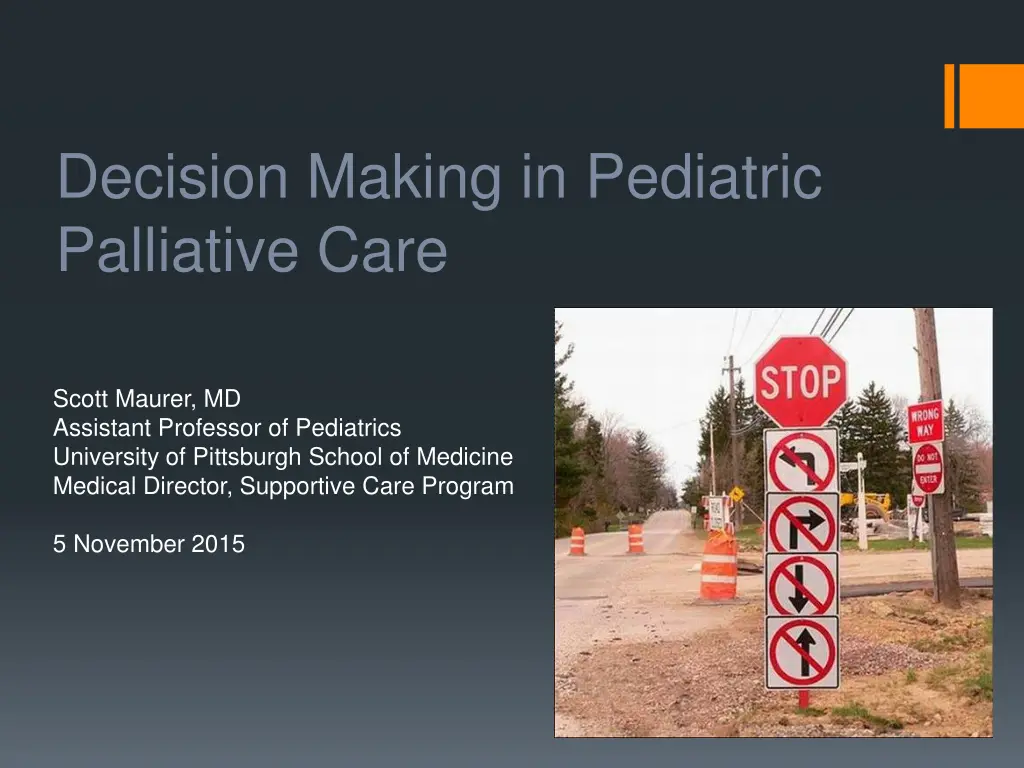
Pediatric Palliative Care Decision Making Insights
Explore the complexities of decision-making in pediatric palliative care, covering end-of-life challenges, support for families, and the impact of parental decisions on bereavement. Learn about the role of a good parent and the significance of making informed, selfless choices for the well-being of a child.
Download Presentation

Please find below an Image/Link to download the presentation.
The content on the website is provided AS IS for your information and personal use only. It may not be sold, licensed, or shared on other websites without obtaining consent from the author. If you encounter any issues during the download, it is possible that the publisher has removed the file from their server.
You are allowed to download the files provided on this website for personal or commercial use, subject to the condition that they are used lawfully. All files are the property of their respective owners.
The content on the website is provided AS IS for your information and personal use only. It may not be sold, licensed, or shared on other websites without obtaining consent from the author.
E N D
Presentation Transcript
Decision Making in Pediatric Palliative Care Scott Maurer, MD Assistant Professor of Pediatrics University of Pittsburgh School of Medicine Medical Director, Supportive Care Program 5 November 2015
Overview Medical decision making at the end-of-life Understanding the Difficulty Goal Setting in Palliative Care How to approach difficult decisions How can we support families and patients? Advance care planning Care coordination Bereavement support
The (un)nature of the situation Death in childhood is rare We are not designed to bury our children End-of-life decision making for children is not natural
Decision Making Parents make many decisions for their children, but the most difficult are: To enroll on Phase I therapy DNR Status Withholding/withdrawing artificial life-sustaining therapies Discontinuation of cancer directed therapy Hinds, PS, et al. Cancer Nurs. 2001.
The issue of regret After the death of a child parents may have decisional regret about: choosing the last course of chemotherapy not talking with their child about death not choosing the location of death Mack, J., et al. J Clin Oncol. 2008. Wolfe, J., et al. J Pain Symptom Manage. 2008. Kreicberges, U., et al. NEJM. 2004.
Morbidity in the bereavement period Significant numbers of parents have difficulty with unresolved grief and experience: High rates of depression Sleep disturbance Increased physician visits Greater likelihood to miss work Lannen, PK. , et al. J Clin Oncol. 2008.
The Role of the Good Parent A sense of being a good parent to the dying child can: Provide emotional relief to the family Possibly decrease morbidity in the bereavement period Hinds, PS., et al. J Clin Oncol. 2009.
What is a good parent anyway? Someone who: Makes informed, unselfish decisions in the child s best interest Meets the child s basic needs Remains at the child s side Protects and advocates for the child Shows love Prevents suffering Teaches moral values Hinds, PS., et al. J Clin Oncol. 2009.
How do parents make decisions? Parents want to do right by their child Suffering plays a key role Quality of Life Need to continue Maurer, S, et al. J Clin Oncol. 2010
What do parents want? Parents want us to provide thoughtful care at the end-of-life: Support the decisions they make. Treat their child the same. Make sure their child doesn t suffer. They also want us to know how much they appreciate the care we provide. Maurer, S, et al. J Clin Oncol. 2010
Approaching Difficult Decisions Setting Goals
A framework for decision making Hope Prognosis Decisions Expectations
Hope and Prognosis Universally parents want their physician to be honest while providing hope Parents are more likely to feel hopeful when they recalled detailed prognostic discussions Increased disclosure correlates with Increased trust Decreased emotional distress Mack,et al., J Clin Oncol, 2007
A framework for decision making Hope Prognosis Goals Expectations
Goals Cure Life prolongation Life prolongation with an emphasis on quality of life Comfort Value of being realistic versus being neutral Recognition of bias we bring to the table Truly believing that there isn t a right or wrong answer
How goals change Cure Life Prolongation Comfort Mild Minimal Moderate High Treatment Intensity Live with Embrace Win Fight Attitude Halt Progress None Eradicate Response Disease Effect Advancing Illness
A framework for decision making Hope Prognosis Goals Decisions Expectations
Decisions Advance Care Planning Symptom Control Social, Emotional, & Spiritual Care CareCoordination Bereavement Care
Advance Care Planning What are the medical decisions that this family needs to make? Withholding disease directed therapy? Participating in a clinical trial? Withdrawing or withholding treatments with curative intent? Do not resuscitate (DNR)? Preferred location of death
The Gray Zone Giving a Choice Making a Recommendation
Symptom Control Enumerate symptoms that are distressing to the child and family Offer suggestions to manage each symptom regardless of its cause Interventions must be considered in the context of the goals of care
Social, Emotional, Spiritual Care Need for Psychologist involvement Need for increased Social Work involvement Need for Child Life involvement Need for family counseling Need for increased Chaplain involvement The importance of talking
Care Coordination Integrate the plan of care Share plan across disciplines
Inpatient Medical Team Social work Child Life Spiritual Care Pharmacy Family/Patient Supportive Care Primary medical team Rehab Services Nursing Nutrition
Care Coordination Integrate the plan of care Share plan across disciplines Multidisciplinary Interdisciplinary Share plan across settings Clinic Hospital Home Health Hospice
Dealing with the aftermath Bereavement Care
Helping Bereaved Families More intense grief is associated with the death of a child when compared to the death of a spouse or a parent Bereaved parents have increased risk of: Anxiety Depression Suicidal ideation Prolonged grief Poor quality of life Poor social function Middleton, et al. Aust NZ J Psych. 1998. Hendrickson. Pall Support Care. 2009. Rosenberg, et al. PBC. 2012.
Siblings Siblings suffer during the child s illness and after their death Psychosocial issues: Sleep disturbance Low self-esteem Delayed maturity Symptoms are worse in the first year Increased anxiety/depression Increased use of alcohol and illicit drugs Almost all siblings claim to be affected by the loss many years later Rosenberg, et al. JPSM 2014. Eilegard, et al. Psychooncology. 2013
Modifiable Factors Parents with more distress: Believed their child was suffering Noted significant financial concerns Noted treatment goals which weren t well aligned with the goal of care Siblings with more distress: Had poor communication with parents at and after the time of death Felt unprepared for their sibling s death Did not have an opportunity to say goodbye Rosenberg, et al. JAMA Peds. 2013 Rosenberg, et al. JPSM 2014.
New Standards of Care Legacy building Links to local mental health resources Access to other bereaved parents Spiritual support Reduction of financial burdens Access to support for a minimum of 13 months Connectivity to the treating institution Opportunity for personal growth Education and support of staff
Patient and family support: Prior to the death Good bereavement care begins at the time of consult Early palliative care involvement Legacy building Companion patient and family in grief Interdisciplinary Team Approach
Family support: At the time of the death Family time with their child Mementos/Legacy Building Sibling Support Leaving without their child
Family support: Bereavement follow up 13 Month follow up Regular contact with families via phone, e-mail, or in person Provision of local resources Grief groups Local mental health providers Autopsy Review with the physician and consultants Memorial Service Legacy opportunities Volunteerism Fund raising Education
Support and Education of Staff Support Scheduled debriefings for nursing staff on various floors and clinics Emergency debriefings after acute events Education: Empowerment of staff for: Care of patients Care of parents/family Care of self






















